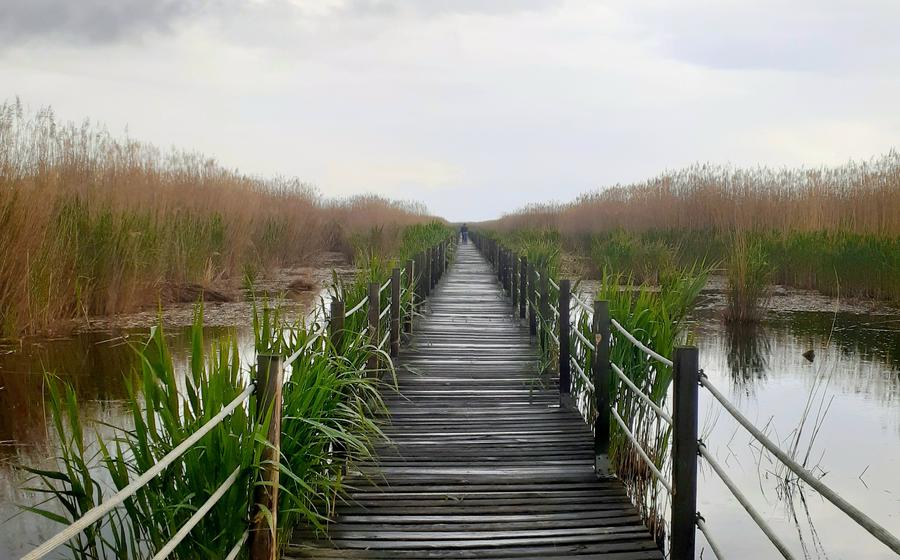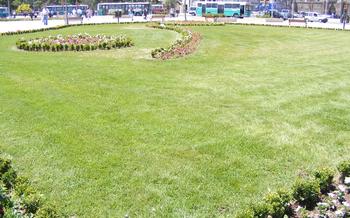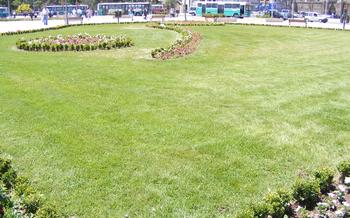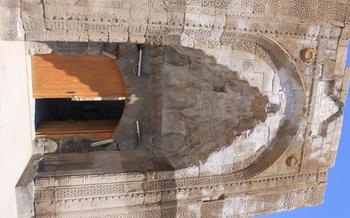
The Grand Mosque (Ulu Cami)
- The Grand Mosque (Ulu Cami): A Masterpiece of Seljuk Architecture
- Exploring the Mosque's Interior: A Journey Through History
- The Minaret: A Tower of Grace and Symbol of Faith
- The Courtyard: A Place of Tranquility and Reflection
- The Museum: Unveiling the Hidden Treasures of the Mosque
- The Neighborhood: Discovering the Charms of Kayseri's Old Town
- The People: Welcoming Encounters and Cultural Exchange
- The Best Time to Visit: Experiencing the Mosque in Different Seasons
- Photography and Videography: Capturing the Mosque's Beauty
- Dress Code and Etiquette: Respecting Local Customs and Traditions
- Accessibility: Ensuring a Welcoming Environment for All
- Guided Tours: Unveiling the Mosque's Secrets with an Expert
- Local Cuisine: Savoring the Flavors of Kayseri
- Souvenirs and Handicrafts: Bringing Home a Piece of Kayseri
- Insider Tip: Uncovering Hidden Gems Around the Mosque
The Grand Mosque (Ulu Cami): A Masterpiece of Seljuk Architecture
Standing tall in the heart of Kayseri, Turkey, the Grand Mosque (Ulu Cami) is a testament to the grandeur and artistry of Seljuk architecture. Built in the 12th century, this awe-inspiring mosque has served as a spiritual and cultural landmark for centuries. Its intricate carvings, majestic domes, and soaring minarets have captivated the hearts of countless visitors, making it one of Kayseri's most iconic architectural wonders.
The mosque's history is deeply intertwined with the rise of the Seljuk dynasty, a powerful empire that ruled over much of Anatolia during the Middle Ages. Commissioned by Sultan Melikşah, the Grand Mosque was designed to be a symbol of Seljuk power and piety. The mosque's construction involved some of the finest artisans and craftsmen of the time, who meticulously crafted every detail to perfection.
Architecturally, the Grand Mosque showcases a harmonious blend of Seljuk and Anatolian styles. Its massive courtyard, surrounded by arched galleries, leads to the main prayer hall, which is supported by imposing columns and crowned by a series of domes. The interior is adorned with exquisite tilework, intricate carvings, and verses from the Quran, reflecting the Seljuk's mastery of decorative arts.
Beyond its architectural significance, the Grand Mosque has played a vital role in the religious and cultural life of Kayseri. For centuries, it has been a place of worship, learning, and community gatherings. The mosque's courtyard served as a venue for religious ceremonies, festivals, and public announcements, while its madrasah, or Islamic school, educated generations of scholars and theologians.
As a traveler, visiting the Grand Mosque is an immersive experience that transports you back in time to the era of the Seljuk sultans. Prepare to be mesmerized by the mosque's grandeur, marvel at its intricate details, and feel a deep connection to the rich history and culture of Kayseri.
Exploring the Mosque's Interior: A Journey Through History
Step inside the Grand Mosque (Ulu Cami) and embark on a journey through time. The mosque's interior is a testament to the artistry and devotion of its builders. The layout is simple yet awe-inspiring, featuring a spacious prayer hall, multiple domes, and intricate decorations.
The prayer hall is the heart of the mosque, where worshippers gather to offer their prayers. The vast space is adorned with elegant columns, graceful arches, and shimmering chandeliers. The mihrab, a niche in the wall indicating the direction of Mecca, is a focal point of the hall, adorned with exquisite tilework and calligraphy.
Look up to admire the stunning domes that crown the mosque's interior. Each dome is a masterpiece of Islamic architecture, showcasing intricate patterns and vibrant colors. The play of light filtering through the stained glass windows creates an ethereal ambiance that enhances the spiritual atmosphere of the mosque.
Throughout the mosque, you will find unique features and symbolism that reflect Islamic beliefs and traditions. From the intricate carvings on the wooden pulpit to the colorful tiles adorning the walls, every detail holds a story. Take your time to explore and discover the hidden meanings and symbolism that make this mosque so special.
As you wander through the mosque's interior, reflect on the spiritual significance of this sacred space. For centuries, this mosque has been a place of worship, contemplation, and community gathering. Feel the serenity and peace that permeate the air as you immerse yourself in its rich history and spiritual ambiance.
The Minaret: A Tower of Grace and Symbol of Faith
The Grand Mosque's minaret stands tall and proud, a symbol of faith that echoes through the city of Kayseri. Built in the 13th century, this architectural marvel boasts intricate tilework and a distinct fluted design that reflects the Seljuk architectural style. The minaret's slender silhouette pierces the sky, guiding the faithful to the mosque for prayers and serving as a beacon of hope and spirituality for the community.
The minaret's construction showcases the remarkable engineering prowess of the Seljuk artisans. Constructed with precision-cut stone and adorned with intricate carvings, it has withstood the test of time, remaining a testament to the enduring legacy of Seljuk craftsmanship. Its fluted design, reminiscent of a delicate flower, adds a touch of elegance and grace to the minaret's imposing structure.
Beyond its structural significance, the minaret holds a profound religious and cultural value. It serves as a platform for the muezzin to call the faithful to prayer, his voice resonating through the city's streets and alleys, inviting the community to come together in worship. The minaret's call to prayer, echoing five times a day, creates a rhythmic melody that weaves its way into the fabric of Kayseri's daily life, reminding its inhabitants of their spiritual connection and the importance of faith.
The Courtyard: A Place of Tranquility and Reflection
The courtyard of the Grand Mosque, known as the avlu, serves as a serene oasis amidst the bustling city. Upon entering, visitors are greeted by a spacious and peaceful ambiance that invites contemplation and reflection. The courtyard's layout is simple yet elegant, featuring a central water fountain surrounded by lush greenery and towering trees.
The water fountain, a common element in Islamic architecture, holds symbolic significance representing purity and renewal. Its gentle murmur creates a calming atmosphere, adding to the courtyard's tranquility. The surrounding trees and greenery provide a refreshing contrast to the stone structures, creating a sense of harmony between nature and architecture.
In the courtyard, visitors can find a sense of respite from the outside world. Whether seeking a moment of solitude or simply admiring the beauty of the surroundings, the courtyard offers a sanctuary for contemplation and reflection. It is a place where one can pause, appreciate the beauty of the mosque's architecture, and connect with the spiritual essence of the site.
As I sat in the courtyard, surrounded by the gentle sounds of water and the rustling of leaves, I couldn't help but feel a sense of peace and tranquility wash over me. It was as if the courtyard had a calming effect, inviting me to slow down and appreciate the present moment. In that serene setting, I found myself reflecting on the mosque's rich history and the significance it holds for the community.
The Museum: Unveiling the Hidden Treasures of the Mosque
Within the hallowed grounds of the Ulu Cami complex, a treasure trove of history and cultural significance awaits discovery at the on-site museum. Established to showcase the mosque's rich legacy, this museum houses a captivating array of artifacts, exhibits, and interactive displays that transport visitors back in time.
Through meticulously curated collections, the museum provides a glimpse into the mosque's architectural evolution, religious practices, and the vibrant history of Kayseri. Rare manuscripts, ancient Qur'anic inscriptions, and intricate decorative elements offer tangible connections to the mosque's past.
Interactive exhibits engage visitors in a multisensory journey, bringing to life the stories and traditions that have shaped the mosque's spiritual significance. Touchscreens, audio guides, and multimedia presentations immerse visitors in the mosque's rich narrative, shedding light on its role as a center of learning, worship, and community gatherings.
For those seeking a deeper understanding of the mosque's architectural marvels, the museum offers detailed models and interactive displays that illustrate the mosque's structural ingenuity and the innovative techniques employed in its construction. These exhibits provide a fascinating glimpse into the minds of the master builders who created this architectural masterpiece.
A visit to the museum is not just an educational experience but also an opportunity to connect with the cultural heritage of Kayseri. The museum's collection serves as a reminder of the city's rich past, its contributions to Islamic architecture, and the enduring legacy of the Seljuk dynasty.
The Neighborhood: Discovering the Charms of Kayseri's Old Town
The Grand Mosque is nestled in the heart of Kayseri's old city, a vibrant and historic neighborhood that invites exploration. As you step out of the mosque's courtyard, you'll find yourself surrounded by a maze of narrow streets, charming old buildings, and bustling shops. The neighborhood is a living testament to Kayseri's rich past and offers a glimpse into the city's vibrant culture.
Take a leisurely stroll through the winding streets and admire the traditional Turkish architecture that lines the way. Many of the buildings in the neighborhood have been beautifully restored and now house shops, cafes, and restaurants. You can find everything from traditional Turkish handicrafts to modern souvenirs in the local shops, making it the perfect place to pick up a unique memento of your visit.
Be sure to stop by one of the many cafes or restaurants in the neighborhood to savor some delicious local cuisine. Kayseri is famous for its mouthwatering dishes, such as mantı (Turkish ravioli) and pastırma (cured beef). Take your time to enjoy a leisurely meal and soak up the lively atmosphere of the old city.
If you have time, explore the other historical landmarks in the neighborhood. The Kayseri Castle, with its imposing walls and towers, is just a short walk from the mosque. The castle offers stunning panoramic views of the city and is a must-visit for history buffs.
The old city of Kayseri is a treasure trove of hidden gems waiting to be discovered. Take your time to wander through the streets, engage with the friendly locals, and uncover the many charms that this historic neighborhood has to offer.
The People: Welcoming Encounters and Cultural Exchange
The people of Kayseri are renowned for their warm hospitality and welcoming nature. As you explore the city and visit the Grand Mosque, you'll have the chance to interact with the friendly locals and learn about their rich culture. The locals take pride in their heritage and are eager to share it with visitors. Don't hesitate to strike up a conversation with shopkeepers, street vendors, or fellow travelers. You'll be met with genuine smiles and helpful advice.
During my visit to the mosque, I had the pleasure of meeting a local family who invited me to join them for tea in their home. They welcomed me with open arms and shared stories about their lives in Kayseri. I learned about their traditions, their love for their city, and their deep devotion to their faith. It was a heartwarming experience that left me with a lasting impression of the genuine kindness and hospitality of the people of Kayseri.
To enhance your cultural exchange, visit the local markets, where you can haggle for souvenirs and sample delicious street food. Immerse yourself in the vibrant atmosphere of the city's cafes and restaurants, where you can sip on Turkish coffee and savor traditional dishes. Remember to be respectful of local customs and traditions, and always ask permission before taking photos of people or places. With an open heart and a willingness to engage, you'll find that the people of Kayseri will welcome you with warmth and generosity.
The Best Time to Visit: Experiencing the Mosque in Different Seasons
The best time to visit Kayseri, and therefore the Grand Mosque, is undoubtedly during the shoulder seasons, spring (April-May) and autumn (September-October), when the weather is pleasant and the crowds are smaller. During these months, you can enjoy exploring the mosque's intricate details and peaceful ambiance without the summer heat or winter chill.
Summer (June-August) in Kayseri can be hot and dry, with temperatures often reaching the high 30s Celsius (100s Fahrenheit). While the mosque offers a cool respite from the scorching sun, the crowds of tourists can be overwhelming. If you do visit during this time, be sure to stay hydrated and plan your visit for early morning or late afternoon to avoid the hottest part of the day.
Winter (November-March) in Kayseri is cold and snowy, with temperatures frequently dropping below freezing. While the mosque remains open during this time, some areas, such as the courtyard, may be closed due to snow and ice. Additionally, the reduced daylight hours may limit your ability to fully appreciate the mosque's exterior.
During the holy month of Ramadan, the mosque takes on a particularly special atmosphere. The nightly prayers, known as Tarawih, are a unique and moving experience, and the mosque is beautifully decorated with lights and lanterns. If you have the opportunity to visit during this time, be sure to take advantage of the extended night prayers and the festive atmosphere.
No matter when you choose to visit, the Grand Mosque of Kayseri is a sight to behold. With its stunning architecture, rich history, and spiritual significance, it is a must-see destination for any traveler to Turkey.
Photography and Videography: Capturing the Mosque's Beauty
The Grand Mosque (Ulu Cami) presents a remarkable opportunity for photography and videography enthusiasts. With its stunning architecture and intricate details, the mosque offers a wealth of visual wonders to capture. However, it is essential to be mindful of the mosque's sacred nature and follow the guidelines and restrictions in place.
Photography and videography are generally permitted within the mosque, but certain areas may be restricted, such as the prayer hall during prayer times. Respectful conduct and appropriate attire are expected, and using tripods or flash photography may be prohibited.
To capture the mosque's grandeur, wide-angle lenses and a sturdy tripod are recommended. The courtyard and exterior provide excellent vantage points for panoramic shots, showcasing the mosque's imposing facade and the surrounding cityscape.
For interior shots, a wide-angle lens is crucial for capturing the vastness of the prayer hall and the intricate details of the decorations. Natural light often provides the best illumination, but a portable light source may be necessary in dimly lit areas.
Patience and observation are key to capturing the essence of the mosque. Take your time to explore different angles and perspectives, experimenting with different focal lengths and compositions. Look for details such as the calligraphy inscriptions, geometric patterns, and unique architectural elements that make the mosque so captivating.
Remember, while capturing the beauty of the mosque, it is equally important to respect the sanctity of the space and the privacy of worshippers. Be mindful of your surroundings and refrain from disturbing ongoing religious activities.
One personal anecdote I recall is during my visit, I noticed a group of local women deep in prayer in a secluded corner of the mosque. Their serene expressions and the soft murmur of their voices created a deeply moving and spiritual moment. I captured a photograph of this scene, ensuring to maintain a respectful distance and not intrude on their private devotion.
Dress Code and Etiquette: Respecting Local Customs and Traditions
When visiting the Grand Mosque, it is essential to be mindful of the local customs and traditions to ensure a respectful and meaningful experience. As a place of worship, the mosque holds significant religious and cultural importance for the community. Visitors should dress modestly and appropriately, avoiding revealing or tight-fitting clothing. Both men and women are expected to cover their shoulders and knees. Women may also choose to cover their hair as a sign of respect.
Upon entering the mosque, it is customary to remove one's shoes and place them in the designated racks or shelves. This practice maintains the cleanliness and sanctity of the prayer space. Visitors should also be mindful of their behavior within the mosque, speaking softly and refraining from engaging in loud conversations or disruptive activities. It is considered disrespectful to point one's feet towards the qibla, the direction of prayer towards Mecca.
Before entering the prayer hall, visitors should perform ablution, a ritual cleansing involving washing specific parts of the body with water. Ablution facilities are usually available near the entrance of the mosque. By following these simple guidelines, visitors can demonstrate their respect for local customs and traditions, creating a welcoming and harmonious environment for all.
Accessibility: Ensuring a Welcoming Environment for All
The Grand Mosque of Kayseri is committed to providing an accessible and welcoming environment for visitors of all abilities. The mosque features ramps and elevators to ensure that individuals with mobility challenges can easily navigate the grounds and interior spaces. Accessible entrances are also available to facilitate seamless entry and exit for visitors using wheelchairs or other mobility aids.
For those who are visually impaired, the mosque offers audio guides and tactile maps to enhance their experience. These resources provide detailed descriptions of the mosque's architectural features and historical significance, allowing visitors to fully appreciate the beauty and grandeur of the space.
The mosque's staff is also trained to assist visitors with disabilities, providing guidance and support as needed. They are available to answer questions, offer assistance with directions, and ensure that everyone has a comfortable and fulfilling visit.
By prioritizing accessibility, the Grand Mosque of Kayseri demonstrates its commitment to creating an inclusive environment where all visitors, regardless of their abilities, can experience the spiritual and cultural significance of this remarkable landmark.
Guided Tours: Unveiling the Mosque's Secrets with an Expert
Enhancing your visit to the Grand Mosque is the opportunity to join a guided tour. Led by knowledgeable guides, these tours offer an immersive experience, delving into the mosque's history, architecture, and cultural significance. With their expertise, guides bring the mosque's stories to life, shedding light on its intricate details and hidden gems. Whether you're a history buff, an architecture enthusiast, or simply seeking a deeper understanding of Islamic culture, a guided tour is an invaluable addition to your mosque visit.
One memorable guided tour I experienced was with a passionate local historian named Mehmet. With his captivating storytelling, he transported us back in time, painting a vivid picture of the mosque's construction and the Seljuk dynasty's reign. Mehmet pointed out architectural elements I would have missed on my own, explaining their symbolism and significance. His insights transformed the mosque from a beautiful building into a living testament to history and faith.
If you're considering a guided tour, be sure to book in advance, especially during peak tourist season. Choose a reputable tour company that offers tours in your preferred language. Whether you opt for a group tour or a private experience, the knowledge and insights shared by your guide will elevate your understanding and appreciation of the Grand Mosque.
Local Cuisine: Savoring the Flavors of Kayseri
Kayseri's culinary scene offers a tantalizing array of delights that will satisfy even the most discerning palate. From hearty kebabs to mouthwatering sweets, the city's cuisine is a reflection of its rich history and cultural heritage.
Must-Try Dishes:
-
Manti: These delicate dumplings, filled with minced meat and topped with yogurt sauce, are a local specialty that should not be missed.
-
Kayseri Pastırması: This air-dried beef jerky is a unique and savory treat, often enjoyed as a snack or as part of a larger meal.
-
Sucuk: A spicy sausage made with beef or lamb, sucuk is a popular ingredient in many local dishes.
-
Katmer: This flaky pastry, filled with cheese, nuts, or minced meat, is a sweet or savory treat that is sure to satisfy.
To truly immerse yourself in the local cuisine, I highly recommend venturing into the city's vibrant markets and bazaars. Here, you can find fresh produce, spices, and traditional sweets, as well as the opportunity to interact with friendly locals who are always happy to share their culinary knowledge.
Recommended Restaurants:
-
Develi Çarşı: This traditional Turkish restaurant offers a wide variety of local dishes, including manti, pastırmalı kuru fasulye (dried beans with pastırma), and Kayseri mantısı.
-
Şevket Usta: Known for its delicious kebabs, Şevket Usta is a popular destination for both locals and tourists alike.
-
Köşk Restaurant: Located in the heart of the city, Köşk Restaurant serves up modern interpretations of traditional Turkish cuisine in a stylish and elegant setting.
Whether you choose to dine at a traditional restaurant or explore the city's culinary offerings on your own, Kayseri's cuisine is sure to leave a lasting impression on your taste buds.
Souvenirs and Handicrafts: Bringing Home a Piece of Kayseri
Kayseri boasts a rich tradition of craftsmanship and produces unique souvenirs and handicrafts that reflect its cultural heritage. As you stroll through the city, you'll find a myriad of shops and bazaars showcasing exquisite carpets, intricate pottery, handmade jewelry, and traditional textiles.
One of the must-have souvenirs from Kayseri is a hand-woven carpet. These carpets are renowned for their vibrant colors, intricate designs, and exceptional quality. You can find a wide selection of carpets in various sizes and patterns to suit your taste and budget.
Another popular souvenir is Kayseri pottery. The city has a long history of pottery-making, and local artisans create beautiful ceramic pieces, including plates, bowls, vases, and decorative items. Each piece is unique, adorned with hand-painted motifs that draw inspiration from nature and traditional Turkish designs.
For those who love jewelry, Kayseri offers a dazzling array of handmade pieces. From delicate silver necklaces to statement-making earrings, you'll find a treasure trove of unique designs crafted by local artisans. The intricate filigree work and colorful gemstones add a touch of elegance and charm to any outfit.
Traditional textiles, such as hand-woven scarves, shawls, and tablecloths, are also popular souvenirs from Kayseri. These textiles often feature vibrant colors and intricate patterns, making them a beautiful addition to any home.
When shopping for souvenirs, it's important to support local businesses and artisans. By purchasing handmade items, you not only take home a piece of Kayseri's culture but also contribute to the preservation of traditional craftsmanship.
One of my favorite souvenirs from Kayseri is a hand-painted ceramic plate that I bought from a small shop near the mosque. The plate features a stunning depiction of the mosque's architecture, and it serves as a beautiful reminder of my time in this historic city.
Insider Tip: Uncovering Hidden Gems Around the Mosque
Beyond the awe-inspiring Grand Mosque, Kayseri's old town conceals a treasure trove of hidden gems waiting to be discovered. As you wander through the labyrinthine streets, keep an eye out for the Bezirhane, a former caravanserai that has been beautifully restored into a cultural center. Its courtyard, adorned with intricate carvings and arches, transports you back to a bygone era.
For a taste of local history, visit the Kayseri Museum, which houses a fascinating collection of artifacts from the city's rich past. From ancient pottery to Seljuk coins, the exhibits provide a glimpse into Kayseri's diverse heritage.
If you're a nature enthusiast, take a stroll through the nearby park, which offers a tranquil oasis amidst the bustling city. With its lush gardens, serene ponds, and shady trees, it's the perfect spot to relax and soak in the peaceful atmosphere.
For a unique shopping experience, head to the old bazaar, located a short walk from the mosque. Here, you'll find an array of traditional handicrafts, carpets, and souvenirs, all made by local artisans. Haggling is expected, so don't be afraid to bargain for the best price.
As you explore the neighborhood, don't hesitate to interact with the friendly locals. They are proud of their city and eager to share its stories and traditions. Whether it's a shopkeeper, a street vendor, or a passerby, each encounter offers an opportunity for cultural exchange and a deeper connection to the heart of Kayseri.









